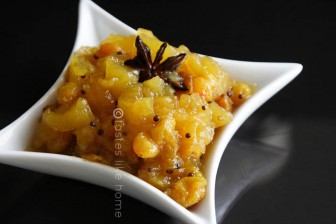Hi Everyone, For us here in the Caribbean, chutneys are hot, spicy, tangy (acidic) condiments. We drool at the thought of a tamarind or mango chutney. And our chutneys go so well with almost anything. So important is chutney to our cuisine that nary a home is without a little bottle or jar of this very savoury blend.
Derived from the Hindi word, chatni, chutney is a wide-ranging family of condiments found in the cuisines of Southern Asia. The influence of our chutney-making techniques and types is as a direct result of Indian cuisine, both Northern and Southern. Achar, another Hindi word, is a type of chutney too. The distinction made when it comes to achar is that achar often contains oil and is rarely sweet.
 Chutneys are broken down further by distinguishing them according to categories such as sweet, savoury, fresh or cooked. In each case, the distinction is made based on the origin of the chutney. While we are very familiar with the savoury chutney(s), which many of us make ourselves, cooked or fresh, we rarely delve into the sweet side of chutney making and dare I say, eating. Frankly, I think we’ve been missing out and it is about time that we get our sweet chutney eating on!
Chutneys are broken down further by distinguishing them according to categories such as sweet, savoury, fresh or cooked. In each case, the distinction is made based on the origin of the chutney. While we are very familiar with the savoury chutney(s), which many of us make ourselves, cooked or fresh, we rarely delve into the sweet side of chutney making and dare I say, eating. Frankly, I think we’ve been missing out and it is about time that we get our sweet chutney eating on!
Here’s my case for us making sweet chutney (as if I need one). It is an ideal way to use up excess fruit. It makes pan sauces unnecessary. It goes well with roast meats and poultry, seafood too. Sweet chutneys are ideal when served with various cheeses, breads and biscuits. And best of all, they are so easy to make – dump all the ingredients into a pot, bring to a boil and then simmer until the liquid is syrupy and the fruits softened. That’s it. Really. And if you really want to show off, mix and match the fruits with various spices to create unique blends.
What I like most about the sweet chutneys is that they can hit all the notes we crave – sweet, sour, savoury, hot and spicy. The deft hitting of all these notes in a sweet chutney is what makes it so versatile as pointed out above. As a side issue, please note that I used the words hot and spicy separately. Too often people outside of this region interchange those words when they refer to our cuisine and for them spicy equals hot, meaning heat from pepper. Spicy here, means the flavours imparted from the spices used.
Here’s a breakdown of the flavour profile of a sweet chutney.

Photo by Cynthia Nelson
The sweetness comes from the fruit itself and the added sugar. A combination of fresh and dried fruits are used to make sweet chutneys but you can certainly use only fresh fruit or rehydrated dried fruit. The state of ripeness of the fresh fruit is always important as the condition has direct bearing on the cooking time for the chutney as well as the taste and overall flavour of the chutney. You want the fruit to be ripe but firm.
Raisins are the most used dried fruit in chutneys because they bring the perfect amount of sweetness and textural contrast to a chutney. Dried prunes, apricots, cranberries, currants and dates are excellent choices too.
The final sweet component of a sweet chutney is unique in the flavour and level of sweetness it brings. Our brown sugar is great but if you can get your hands on other natural sugars such as jaggery, coconut sugar, palm sugar, rock sugar, Piloncillo Cones (Mexican raw sugar) or Brazilian raw block sugar, they will bring their own unique flavour to the party.
The sour for the chutney will come mainly from the vinegar used and residual tartness from the fresh fruit.
Salt will come from the addition of table or sea salt; heat from hot peppers and ginger if using. Or if you have some of that pepper jam I told you about last year, you can certainly add a little to the mix.
The spiciness from any of the spices used – cinnamon, cloves, star anise, mustard seeds, nutmeg, allspice and cardamom. Please note that at any point in time, you do not use all of the spices at one time in a sweet chutney. You choose the spices according to how their flavour profiles will match/compliment that of the fruit being used.
There are certain fruits that pair exceptionally well with meats, poultry and seafood and vice versa (pork with pears, grapes and raisins, lamb with prunes, dates and guava; duck with oranges and mangoes; chicken with apples, limes and papaya; seafood with tamarind, five finger, raisins and pineapples), but do not restrict yourself to just the natural pairs, try different combos. When entertaining, depending on your guests, you can try new combos or stick to what is traditional. Always ease people in gently when asking them to try new things. That’s what I did earlier this year when I had some overseas guests; I made them Griot (Haitian style of twice cooked pork) and given that they (my guests) are accustomed to the kind of dining that would require a sauce for such a meal, I decided to pair it with an apple chutney, something that I knew they would appreciate and be comfortable eating with the meal.
So if you’re planning a roast for this Sunday’s meal, look around and see what fruits are in season and try making a sweet chutney to go along with the meal.
Here’s my apple chutney recipe. You can make it with any of the varieties of apples we get here in the Caribbean: Gala, Red Delicious, Fuji, Golden Delicious or Granny Smith. The Granny Smith tends to stand up well to long cooking and has a little tartness to it which makes it great for cooking but like I said, any of the other varieties will do. For the chutney I made, I used gala apples – those are the small red ones with areas of light pink, light cream. These are the ones we get all the time.
Apple Chutney
INGREDIENTS
10 – 12 apples (about 2 lbs.), peeled, cored and cut into bite-size chunks
1+¼ cups of sugar (brown or white)
¾ cup apple cider vinegar (or use regular vinegar if you don’t have)
¾ cup raisins (brown or golden)
1+¼ teaspoons black or brown mustard seeds
1 large whole star anise
1 x 2-inch piece cinnamon stick
1 teaspoon minced hot pepper (or to taste)
¾ teaspoon salt
DIRECTIONS
1. Add all the ingredients to a pot (preferably a heavy-bottomed pot), stir to mix, cover and bring to a boil. When the pot comes to a boil, remove the lid and reduce heat to low and let simmer, stirring frequently until the liquid becomes thick and pulpy, about 35 – 45 minutes.
2. Taste three-quarter way through cooking to see if the sweet-tartness suits your taste and adjust if necessary, if not continue cooking until done.
3. Remove pot from heat and let cool completely before transferring to sterilized jars and refrigerate.
4. Let the chutney cure for a day before serving (or, make it early in the morning to serve in the evening). Serve chutney at room temperature.
Cynthia









